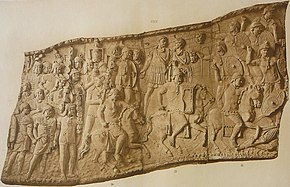The focale (plural focalia), also known as a sudarium ("sweat cloth"),[1] was a woolen or linen scarf worn by ancient Roman military personnel. It protected the neck from chafing by the armor and was used for warmth.[2][3][4] The focale is depicted widely in military scenes from Roman art, such as the relief sculpture on the Arch of Septimius Severus in the Roman Forum[5] and Trajan's Column.[6] It is shown loosely knotted in the front, but is sometimes visible with the ends tucked inside the cuirass.[1]


In Latin literature, focale is a general word for a scarf or wrapping for the throat.[7] A focale was one of the gifts that might be given for the December festival of Saturnalia, according to Martial.[8] In one of his satires, Horace lists focalia among the "badges of illness" (insignia morbi).[9] In describing the correct attire for public speaking, Quintilian advises against wearing a focale, unless required by poor health.[10]
Although a sudarium often is used as a handkerchief, it can be worn like the focale as a neckerchief.[11] When Suetonius describes the overly casual attire of Nero, the emperor is barefoot, unbelted, and dressed in evening wear (synthesis), with a sudarium around his neck.[12] The sudarium may be the precursor to the focale.[13] In late antiquity, orarium (Greek orarion) might be synonymous with focale, as in the description of military attire in the Vision of Dorotheus, and in a papyrus (dated 350–450 AD) listing military clothes.[14] From the sudarium derives the name of the Near Eastern sudra, a similar piece of cloth with various functions over time.[15]
The focale is sometimes seen as one of the precursors of the necktie.[16] Cesare Vecellio (1530–1606) mentions the focale, calling it a cravata (cravat), as worn by Roman soldiers in his book on the history of fashion.[17] It has been compared to the amice (amictus) worn by Roman Catholic priests, which is depicted from the 6th century onward, as in the Ravenna mosaics.[18]